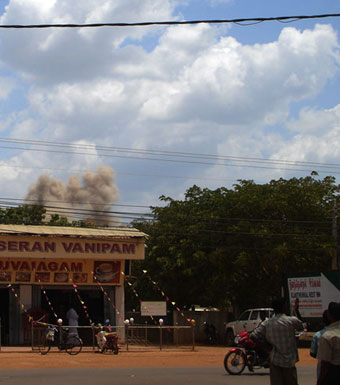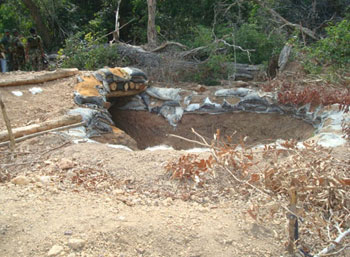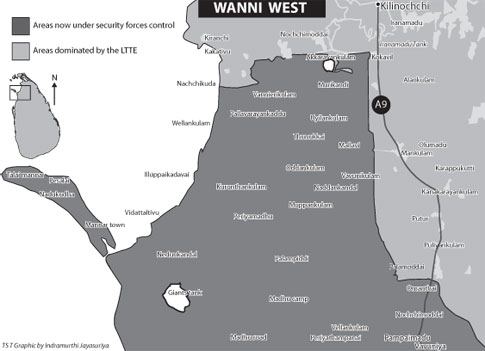Troops now on the doorstep of Tiger guerrilla strongholds in the Wanni carried out a series of probes into their enemy positions this week. This was whilst directing artillery fire at their targets.
Among the reasons for the caution that somewhat slowed down hectic military activity was to allow civilians who had converged on Kilinochchi to move out to secure areas. As reported last week, the guerrillas have ordered those arriving in their centre of political power to leave for several villages in the Mullaitivu district. They include Puthukudiyiruppu, Visvamadu and Vattakachchi.
 |
| Yesterday’s (27 Sep, 2008) picture in the Tamilnet website shows smoke billowing after the Air Force carried out a bombing raid near the Kilinochchi town. |
On Friday and yesterday the Air Force intensified their bombing campaign on guerrilla targets in the Wanni. Some of the bombs fell in areas in and around the Kilinochchi town. With this, the coming week will see troops fighting their way to re-capture more areas. One of the focal points will be Kokavil, a small town on the A-9 highway. The area assumed significance in the past years in view of a transmission tower for radio and TV broadcast serving almost the entirety of the Wanni region. The guerrillas have damaged it.
The troops, now somewhere on the outer fringes north of Murukandi are only a short distance away from Kokavil. Ahead of them, the guerrillas have heavily fortified their defences in the village of Therumurukandi. Cadres deployed in other areas were withdrawn to be positioned there. The troops re-capture of this small township will see them arriving on the A-9 highway. The distance from there to Kilinochchi is 22 kilometres. Already artillery fire from troops is falling on guerrilla targets in the Kilinochchi town and its immediate environs.
Kilinochchi, as is now known, is the centre of political power for the Liberation Tigers of Tamil Eelam (LTTE). By yesterday, reports said, 85 per cent of the civilians in the area have evacuated the town and its environs. Some offices run by the guerrillas have been shifted. Some of the camps have also been shifted though the guerrillas remain in the area. Schools that catered to 30,000 children are closed. Only the Kachcheri (District Secretary's Office) functioned with limited staff. The re-capture of this town by troops would be the formal end of a so-called LTTE parallel administration from Kilinochchi.
The movement of food supplies to the Wanni has become an item of priority. Whilst the Government has received reports that some food stocks remain, other reports spoke of a shortage. The Government earlier ordered the United Nations officials in the Wanni to withdraw to Vavuniya, the northernmost town under their control, but it has now relaxed the restriction to allow UN officials to accompany food convoys.
The UN office in Colombo was busy making arrangements for a convoy of some 60 to 70 lorries. It will be several days before it moves out. A number of snags would have to be ironed out. UN officials would naturally want to avoid the battle areas and its immediate environs when the convoy moves.
 |
| This was once part of Tiger guerrilla defended localities in Akkarayan. The area was re-captured recently by troops of the Army’s 57 Division. |
This would mean a part of the journey through the A-9 highway and thereafter veering east ahead of the battle zones. However, the LTTE wants them to use the A-9 route with assurances of safe conduct. Senior Army officials wonder whether this is a ploy to force the troops to temporarily halt any military action. Even if all the snags are cleared to facilitate the movement of food convoys, an escalation of fighting is likely to cause difficulties.
Another focal point of attention for troops is the areas in and around the coastal village of Nachchikuda, once a major Sea Tiger base. In the wake of troops advance past Vidattaltivu, the guerrillas emptied their base by shifting all logistics to Kilinochchi. They also drastically scaled down operations in this part in the Palk Straits. Unlike in the Gulf of Mannar where larger naval craft cannot operate due to the shallow waters, their gunboats and fast attack craft patrol the seas here. In addition, on the Indian side of the International Maritime Boundary Line (IMBL), there is regular patrolling by the Indian Coast Guard.
Troops in this flank are now on the southern and southeastern outskirts of Nachchikuda. The area ahead of them was being heavily mined and the guerrillas were also placing booby traps using IEDs (Improvised Explosive Devices).
This week troops broke through a bund that the guerrillas had constructed at two different points. The locations cannot be disclosed for obvious reasons. This bund extends from the Nachchikuda area until a location near Akkarayan. Constructed with earth moving machinery seized from international organisations carrying out development work in the Wanni, the bund is intended as an obstacle to prevent troop advance. The guerrillas expect the moat like ditch that runs alongside the bund, some eight to ten feet deep, to fill up when the northeast monsoon is in full swing.
In this backdrop, troops will no doubt fight some fierce battles in the coming days and weeks to thrust their way through newly fortified guerrilla defences.
This is whilst the Air Force keeps the increased pressure by bombing guerrilla targets including their defended localities.
In the sector north of Weli Oya where troops of the Army’s 59 Division are advancing, reports yesterday said guerrilla groups were placing mines ahead of the terrain they hold. However, troops in the sector, like in the Wanni west, have been clearing those mines as they forged ahead.
In another move, the guerrilla leadership in the Wanni have ordered their cadres from the East, now fighting in the north, to proceed to their respective districts. The districts are Trincomalee, Batticaloa and Ampara. This includes some leaders now in charge of units in the Wanni. The aim is quite obvious. The guerrillas fear troops in the East will be thinned out to enhance the pressure on them in the Wanni. "We do not have to pull troops from the East. We will soon show them (the guerrillas) we are capable of carrying out the task on our own," a senior Army officer in the Wanni told The Sunday Times on the telephone. He spoke on grounds of anonymity since he is not authorised to speak. Other very important aspects relating to this matter cannot be discussed for reasons that are now obvious.
In the East, besides the troops there, even cadres of the Tamil Makkal Viduthalai Pulikal (TMVP), are now assisting the security forces and the police. Security officials in the East believe any guerrilla presence would thus be identified early and preventive action taken.
Another development of some significance was the comments made by the United States Ambassador Robert Blake, at the inauguration ceremony of the Kalawanchikudy Vocational Training Centre on Monday. It was a US Government funded project.
Mr. Blake declared, "….the central Government and the elected Chief Minister must assert responsibility for security, end the abductions and extra-judicial killings and other security challenges that continue, and demobilize paramilitaries, including all child soldiers. Only then will we see the Eastern Province attract significant private sector investment and realize its great potential.
"I had the honour of meeting the Chief Minister (Sivanesathurai Chandrakanthan alias Pillayan) this morning to discuss these important issues. I was pleased that he assured me that he too is committed to demobilizing the paramilitaries and ending the gun culture that has prevailed in many parts of eastern Sri Lanka."
The US envoy's comments come as his President, George W. Bush, is due to give his assent to the Child Soldiers Accountability Act of 2008. This law makes it a federal crime to knowingly recruit or use soldiers under the age of 15 and permits the United States to bring charges under the law against both US citizens and non-citizens who are in the United States. Contrary to reports that the law would affect only the LTTE that recruited child soldiers, Ambassador Blake's remarks confirmed that it applied equally to the TMVP, known to have child soldiers on its roll.
The Sunday Times has obtained a copy of The Child Soldiers Accountability Act of 2008 already approved by both the US House of Representative and the Senate. Its preamble states that the aim of the law is "to prohibit the recruitment or use of child soldiers, to designate persons who recruit or use child soldiers as inadmissible aliens, to allow the deportation of persons who recruit or use child soldiers, and for other purposes." Here are highlights:
- whoever knowingly recruits, enlists or conscripts a person under 15 years of age in an armed force or group or uses such person to participate in active hostilities will be fined or imprisoned for not more than 20 years, or both. If death of any person results, they are liable for fines and any term of years for life.
- The jurisdiction of the new law will apply if the alleged offender is a national of the United States, or an alien lawfully admitted for permanent residence in the United States, or is a stateless person whose habitual residence is United States, is present in the United States irrespective of the nationality of the alleged offender. Others who are aliens and found to be in the United States will become deportable.
The new law defines "participate actively in hostilities" as (a) combat or military activities related to combat, including sabotage and serving as a decoy, a courier, or at a military checkpoint, or (b) direct support functions related to combat, including transporting supplies or providing other services.
The new law defines "armed force or group" as any army, militia or other military organisation, whether or not it is state sponsored, excluding any group assembled solely for nonviolent political association.
The move comes as the US Government is set to review its prohibition order that lists armed groups as "terrorist organisations." This includes the LTTE. The list is reviewed every two years.
More than any time before in the various phases of the separatist war, the fourth phase of the Eelam War has assumed the most critical phase. The days and weeks of this most critical phase now begins. |




